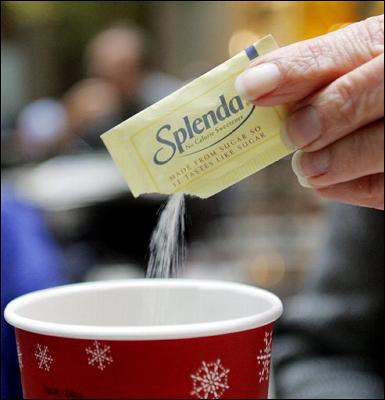
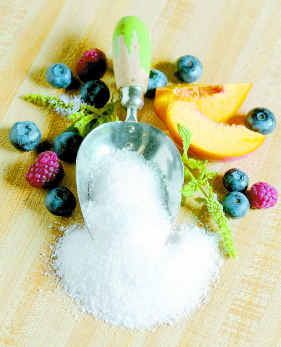
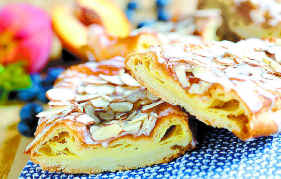 |
| The recipe for Almond Puff Loaves might sound complicated but is easy to make. |
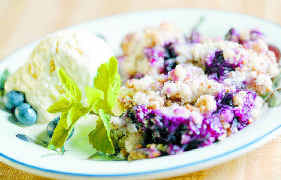 |
| Blueberry Crisp is a warm blueberry filling with a crumbly topping augmented with pecans. |
|
|
||||||
 |
||||||
| Photos by NICK KOON/Knight Ridder Tribune | ||||||
Splenda,
a brand name for the substitute sweetener
sucralose, is the only no-calorie substitute
made from sugar.
|
From Star News Services Posted on Wed, Dec. 01, 2004
It's December, and you know what that means: little plates of sweet baked goods tempting you at every turn.
But in a country where the rates of obesity and diabetes are burgeoning, some holiday cooks are looking for an option to all that sugar. Some think they may have found a savior in Splenda.
Splenda is the first no-calorie, no-carbohydrate sweetener whose sweetness doesn't change when it's heated. Unlike aspartame (Equal) and saccharin (Sweet 'N Low), it can be used in cooking and baking, and carb-conscious home cooks are gobbling it up.
Splenda accounts for about half the supermarket sales of sugar substitutes in the United States, according to IRI, a Chicago market research company. Cookbooks with recipes for Splenda blintzes and cakes are proliferating. And sucralose, the sweetener in Splenda, is the new darling of food manufacturers, showing up in commercial baked goods and sodas, including Coca-Cola and Pepsi's new midcalorie colas.
Sucralose was discovered in a British lab in the 1970s and was approved by the Food and Drug Administration in 1998. As Splenda, it went on the U.S. market in 2000.
Sucralose claims a clean chemical pedigree because it is made from sucrose, a natural sugar. Chlorine is added to the sucrose, and a chemical reaction changes the sucrose molecule to replace some of the hydrogen-oxygen groups with chlorine. That prevents the body from metabolizing it in the same way it does sugar.
This also allows Splenda's U.S. manufacturer, McNeil Nutritionals, to state on the label that it's made from sugar, suggesting that it's natural.
The addition of chlorine has provoked Splenda's critics to call it a chlorocarbon, a chemical found in pesticides. In fact, Splenda is neither natural nor a pesticide. It's a new chemical.
|
Chemical name
: 1,6-dichloro-1,6-dideoxy-beta-D-fructofuranosyl |
Studies have shown that it causes no immediate health problems, but most of these studies have been done by the manufacturer, and no one yet knows what long-term ingestion of large amounts might do over a lifetime.
Although sugar replacements have been around for decades, many leave an unpleasant aftertaste. Most don't hold up well when used for baking.
Granular Splenda, however, has less aftertaste and measures tablespoon-for-tablespoon like sugar. Could it be the secret weapon in Americans' battle to cut carbs, control blood sugar and lose weight?
Probably not, according to chefs who baked with Splenda for the San Francisco Chronicle. They reported disappointing results and said that working with Splenda was like a trip to an alternate universe where nothing went as it should.
The San Francisco chefs found a pattern with the brownies, cookies and cupcakes they baked. The ones made with real sugar rose, had a moist, light texture and browned nicely. The ones made with Splenda were flat, dense and dry.
A batch of brownies made from a basic Fannie Farmer recipe was a good example. The Splenda brownies were flat, dense as a board, incredibly dry and tasteless, but with a sweet aftertaste. They look like a potholder, one chef quipped. Or a tile floor, said another.
The chefs also ran into problems with nonbaked desserts such as vanilla ice cream and creme brulee. The Splenda left the ice cream so hard it broke into shards when scooped, and it made a custard that one chef said looks like airline scrambled eggs.
Taste, too, was definitely an issue with the Splenda desserts. After the first bite, the Chronicle reported, Splenda's sweetness took a few moments to come on. Then it was concentrated on the very tip of the tongue, never reaching the rest of the taste buds.
The sweetness also seemed to block other flavors, the testers said. The egg yolks, cream and vanilla in the ice cream and creme brulee simply disappeared, and even the cocoa in the brownies barely came through. An odd sweetness lingered long after the food was gone.
None of this is news to Splenda's maker, which has posted tips for baking with Splenda on its Web site, www.splenda.com. According to the site, fruit fillings are one of the best uses for Splenda, because the sweetener is simply used for sweetening. Splenda doesn't work the same as sugar for adding volume and texture to baked goods, nor does it promote browning. So to bake with it, adjustments are needed. (See box at right.)
The Orange County Register tested three recipes for fruit desserts using real sugar and Splenda. In side-by-side blind taste tests, the Splenda desserts did well. The two versions of a fruit crisp, for example, baked up beautifully brown. Although one taster thought the dessert made with real sugar was slightly sweeter and had a more interesting taste, other tasters could tell no difference. A cobbler that was tested had flatter biscuits and baked more quickly, but the fillings tasted the same.
Blueberry crisp Makes 10 servings
For the filling:
4 generous cups blueberries, cleaned, stemmed
1/2 cup sugar or Splenda Granular
1/4 cup unbleached flour
1/4 teaspoon salt
2 teaspoons lemon juice
For the topping:
1 1/2 cups unbleached flour
1/4 teaspoon salt
1/2 cup sugar or Splenda Granular
10 tablespoons (1 1/4 sticks) butter, melted
1 cup walnuts or pecans, chopped
Grease and flour 9-inch pie pan. Preheat oven to 350 degrees.
For the filling, place berries in prepared pan. Combine sugar (or Splenda), flour, salt and lemon juice and stir. Sprinkle over berries. Set aside.
For the topping, in medium mixing bowl, stir together flour, salt, sugar (or Splenda), melted butter and nuts. Sprinkle topping over fruit.
Bake 45 to 50 minutes, until top is golden and filling is bubbly. Cool slightly. Per serving, with sugar: 367 calories (45 percent from fat), 19 grams total fat (8 grams saturated), 31 milligrams cholesterol, 46 grams carbohydrates, 6 grams protein, 228 milligrams sodium, 3 grams fiber.
Per serving, with Splenda: 328 calories (51 percent from fat), 19 grams total ft (8 grams saturated), 31 milligrams cholesterol, 35 grams carbohydrates, 6 grams protein, 266 milligrams sodium, 3 grams fiber.
Adapted from The King Arthur Flour Baker's Companion
Bumbleberry cobbler Makes 10 servings
About 8 cups fresh or frozen berries, a mixture of blackberries, blueberries and raspberries (about 2 pounds)
1 tablespoon cornstarch
1 cup plus 1 tablespoon sugar or Splenda Granular
2 1/3 cups unbleached all-purpose flour
1 tablespoon baking powder
1/4 teaspoon salt
4 tablespoons (1/2 stick) butter
3/4 cup buttermilk
1 large egg
Preheat oven to 350 degrees. Grease 9-inch round cake pan that is 3 inches deep. Or use 9-inch square baking pan or 2-quart casserole. Cobbler will bubble up and spill over if pan is too shallow.
Place berries in prepared pan. Mix cornstarch with 1 cup sugar (or Splenda); sprinkle over fruit. Set aside.
Place flour, 1 tablespoon sugar (or Splenda), baking powder and salt in mixing bowl. With fingertips or pastry cutter, mix butter into dry ingredients until mixture looks like coarse cornmeal. In smaller bowl, beat together buttermilk and egg. Make well in center of dry ingredients and pour buttermilk mixture in center. Quickly mix with spoon, taking about 20 seconds. Dough will be wet and sticky, but you can keep it under control if you keep everything that comes in contact with it well floured.
Turn dough onto well-floured work surface and knead or fold over gently until it is reasonably cohesive. Scrape into ball and gently roll to get a circle to cover berries. It can be a bit smaller in diameter than the pan because it will expand as it bakes. Place over fruit and bake 45 minutes, or until lightly browned and fruit is soft and bubbly. If using Splenda, lightly spray top of dough with nonstick vegetable spray before placing in oven.
Per serving, with sugar: 307 calories (17 percent from fat), 6 grams total fat (3 grams saturated), 32 milligrams cholesterol, 61 grams carbohydrates, 5 grams protein, 279 milligrams sodium, 4 grams fiber.
Per serving, with Splenda: 253 calories (22 percent from fat), 6 grams total fat (3 grams saturated), 35 milligrams cholesterol, 45 grams carbohydrates, 5 grams protein, 311 milligrams sodium, 8 grams fiber.
Adapted from The King Arthur Flour Baker's Companion
Almond puff loaves
The powdered-sugar glaze is the crowning touch on these almond puff loaves. To make the glaze using Splenda, see the recipe for Splenda version of powdered sugar icing.
Makes 2 loaves, 10 slices each
For the pastry:
1 cup (2 sticks) butter, plus butter for greasing pan, divided
2 cups unbleached all-purpose flour, divided
1 1/4 cups water, divided
3 large eggs, room temperature
1 teaspoon almond extract
For the topping:
1 (10-ounce) jar of jam or preserves, sweetened with sugar or sugar substitute, or no-sugar-added fruit spread
1/2 cup sliced almonds
For the icing:
1 cup powdered sugar (for Splenda-sweetened version, recipe follows)
2 to 3 tablespoons milk
1/2 teaspoon vanilla extract
Preheat oven to 350 degrees. Grease a large baking sheet.
Using fingertips or pastry cutter, cut 1 stick butter into 1 cup flour until mixture forms coarse crumbs. Stir in 1/4 cup cold water. Form into ball and divide in half. On prepared sheet, pat each half into a 3-by-11-inch rectangle, spacing rectangles 4 inches apart. Slide a metal icing spatula dipped in cold water alongside and over top to smooth surfaces.
Place 1 cup water in medium-large saucepan and add 1 stick butter. Bring to a boil over high heat, stirring until butter melts completely. Remove from heat and pour into bowl of electric mixer. Add 1 cup flour and stir vigorously until mixture forms a mass. Add eggs 1 at a time, beating well after each addition. Beat in almond extract. Divide butter mixture in half. Drop by spoonfuls on top of each pastry base, covering completely, top and sides. Bake 1 hour or until golden brown. Frost tops with jam and set aside to cool.
While puffs are cooling, prepare icing. Mix powdered sugar, milk and vanilla to make a thin icing. When puffs are completely cool, drizzle them with icing. Sprinkle tops with nuts.
Per slice: 214 calories (47 percent from fat), 12 grams total fat (6 grams saturated), 57 milligrams cholesterol, 24 grams carbohydrates, 7 grams protein, 105 milligrams sodium, 1 gram dietary fiber.
Per slice, with Splenda icing: 205 calories (49 percent from fat), 12 grams total fat (6 grams saturated), 57 milligrams cholesterol, 21 grams carbohydrates, 7 grams protein, 105 milligrams sodium, 1 gram dietary fiber.
Adapted from The King Arthur Flour Baker's Companion
Splenda version of powdered sugar icing Makes about 1/3 cup icing
1 1/2 cups Splenda Granular
1/4 cup cornstarch
5 to 6 teaspoons water
1/2 teaspoon vanilla extract
Place Splenda and cornstarch in blender. Cover and whirl until ground into very fine powder. Pour into small bowl. Add water and vanilla and stir well to combine.
Splenda Granular works best as a substitute for sugar in recipes where sugar is used primarily to sweeten, such as pie fillings, cheesecakes, sweet sauces, beverages and marinades. In recipes where sugar would add bulk, texture, moisture and browning, adjustments must be made if Splenda is used instead. Some baking tips:
Creaming: When beating butter or margarine with Splenda, the mixture appears less smooth than when sugar is used. Mixture may separate when eggs are added. According to the Splenda folks, this is normal.
Browning: Sugar promotes browning of baked goods, but when little or no sugar is used surfaces don't caramelize. To aid browning, lightly spray with nonstick vegetable spray just before placing in oven.
Texture: Cookies rely on brown sugar for a chewy consistency. To retain that texture, replace only the white granulated sugar in cookie recipes. You may need to flatten cookies before baking to aid spreading.
Baking time: Baked goods made with Splenda may bake more quickly than those made with sugar. Check cakes seven to 10 minutes early, check cookies three to five minutes early.
Confections: In recipes with very high sugar contents (such as frosting or candy), sugar often contributes to texture and structure. For best results, replace only about 25 percent of sugar with Splenda.
Volume/height: Smaller yields and reduced rise can be expected when using Splenda.
Storage: Sugar acts as a preservative and helps retain moisture. All fresh baked goods made with Splenda are best eaten within 24 hours. If you wish to keep them longer, wrap well and freeze.
Source: www.splenda.com
By J.M. HIRSCH, Associated Press Writer
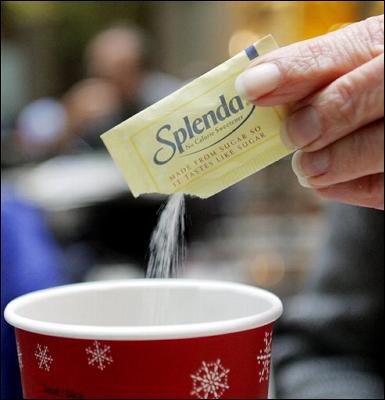 |
|
|
- Dieters hoping for a slew of new products with the sugar substitute Splenda may be disappointed next year.
That's because the maker of sucralose, the key ingredient behind the increasingly ubiquitous no-calorie sweetener, is having trouble keeping up with demand.
Tate & Lyle PLC, the world's only manufacturer of sucralose, said interest has so outpaced expectations the company won't take on new U.S. customers until it has doubled production at it's plant in McIntosh, Ala., sometime in early 2006.
The company also plans to open a second plant in Singapore, according to a written statement.
Buoyed by a surge in anti-sugar diets such as Atkins and South Beach, Splenda has enjoyed sweet success since its introduction in 2000, appearing in everything from soda and ice cream to candy and jams.
Splenda, which won fans with its sugar-like sweetness and stability in baking, now dominates the $337 million U.S. retail market for sugar substitutes, beating out aspartame sweetener Equal, made by Chicago-based Merisant Corp.
"Sucralose has one of those problems that's both good and bad to have," said John Sicher, editor of Beverage Digest. "The demand is tremendous. The supply is constrained."
Splenda is sold to consumers as a table and baking sugar substitute by McNeil Nutritionals LLC, a Pennsylvania-based unit of Johnson & Johnson. Consumer sales won't be affected by the tight supply, a company spokeswoman said.
Sales of sucralose to manufacturers as an ingredient for use in other products are handled directly by Tate & Lyle, which is headquartered in London.
How many new sucralose-sweetened products will come to market is difficult to tell, says Sicher. It depends largely on how many products already have been developed and how much sucralose companies bought in advance.
He says it's too soon to tell how the tight supply might affect existing sucralose-based products at large companies, such as Coca-Cola Co.'s low-calorie "C2" cola, but Tate & Lyle said the Alabama plant will meet the needs of existing customers.
A Coke spokeswoman wouldn't comment.
Small companies hoping to expand or introduce low-cal products likely will face the most trouble.
Atkins Nutritionals helped spur Splenda's surge by endorsing its use in the company's hugely popular low-carb diet. Matthew Wiant, chief marketing officer for Atkins, estimates sucralose is used in as many as 10,000 products. But he doesn't think companies will have a problem switching to other sweeteners if they can't get it.
Lyn Nabors of the Calorie Control Council, a nonprofit trade group, said more companies probably will switch to sugar and sweetener blends, which have fewer calories but require less of the substitute.
Companies who insist on pure sucralose may have to delay new products, she said.
Dan Conner, a co-owner of Conner Bottle Works, a small Newfields, N.H., company that makes old-fashioned glass-bottled sodas, started feeling the Splenda squeeze two months ago. That's when he got a letter from Tate & Lyle telling him he could buy only small amounts of sucralose each month.
He said that for many years his company resisted making diet sodas because the available sugar substitutes didn't taste right. But sucralose was different, and this year Conner added two diet sodas.
But with supplies tightening, Conner now hopes another company will introduce a sucralose competitor, since the cost of sucralose has jumped significantly.
"Maybe we'll get some price wars going to help people like myself," he said.
Merisant, which acquired the Equal business from Monsanto Co. in 2000, recently sued McNeil Nutritionals, accusing it of false advertising by claiming Splenda is made from sugar.
McNeil Nutritionals claims the lawsuit is without merit, saying sucralose starts as cane sugar.